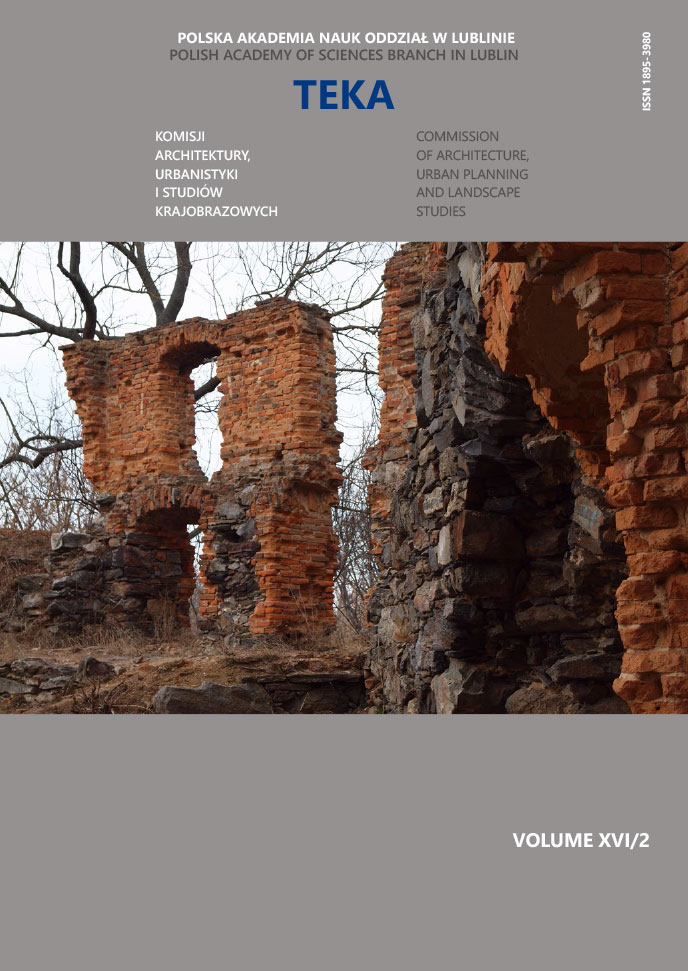Use of laminated timber in the construction of high-rise buildings, on the example of implementations from western countries
Article Sidebar
Open full text
Issue Vol. 16 No. 2 (2020)
-
Perception and functionality of space in view of potential and dysfunction of senses
Sense-sensitive Architectural DesignAgata Gawlak, Magda Matuszewska, Agnieszka Ptak, Magdalena Priefer7-16 -
Nineteenth-century, non-existent buildings of the Castle Hill in Lublin
Krzysztof Janus17-25
-
Freehand drawing as a basic means of artistic expression in the process of educating future architects versus modern computer technology
Agnieszka Chęć-Małyszek26-36
-
The image of the spa town of Szczawno-Zdrój in light of the transformation of the city of Wałbrzych at the turn of the 20th and 21st centuries
Marek Piróg37-43
-
Contemporary architectural interventions in the historical tissue of Cádiz – contextual minimalism in the service of genius loci
Joanna Białkiewicz44-56
-
The Community House (Dom Ludowy) in Nałęczów as an example of social architecture of the early 20th century
Kamila Lucyna Boguszewska57-67
-
Architecture and typhlology. The potential of scientific partnership
Agnieszka Kłopotowska68-75
-
Use of laminated timber in the construction of high-rise buildings, on the example of implementations from western countries
Michał Dmitruk76-87
-
Zbór kalwiński w Piaskach – od ruiny do trwałej ruiny
Piotr Gleń88-93
-
Artistic painted decorations on the outside walls of the castles in western Ukraine
Mykola Bevz94-106
-
Revitalization of the city’s riverside areas on the example of the urstromtal of the Malczewski Stream in Radom
Margot Dudkiewicz, Marek Dąbski, Sylwester Kaczmarski107-112
Archives
-
Vol. 18 No. 4
2022-12-30 5
-
Vol. 18 No. 3
2022-12-27 5
-
Vol. 18 No. 2
2022-12-27 5
-
Vol. 18 No. 1
2022-12-27 4
-
Vol. 17 No. 4
2021-12-30 11
-
Vol. 17 No. 3
2021-12-30 9
-
Vol. 17 No. 2
2021-12-30 8
-
Vol. 17 No. 1
2021-12-30 8
-
Vol. 16 No. 4
2020-12-30 11
-
Vol. 16 No. 3
2020-09-30 10
-
Vol. 16 No. 2
2020-06-30 11
-
Vol. 16 No. 1
2020-03-31 10
-
Vol. 15 No. 4
2019-12-30 6
-
Vol. 15 No. 3
2019-10-31 9
-
Vol. 15 No. 2
2019-06-28 12
-
Vol. 15 No. 1
2019-03-29 13
-
Vol. 14 No. 3
2018-10-28 14
-
Vol. 14 No. 2
2018-06-29 14
-
Vol. 14 No. 1
2018-03-30 13
Main Article Content
DOI
Authors
Abstract
The architecture of modern, 20th and early 21st century high-rise buildings is primarily associated with materials such as steel, glass and concrete. With the advancement and popularity of laminated timber construction in western countries the use of wood as a structural component in high rise buildings brings many economic, technological and logistical benefits. Laminated timber is more flexible, lighter and often more durable than typically used materials in construction. Thanks to cross lamination technology, buildings are able to obtain significant heights while maintaining appropriate structural requirements. This material turns out to be easier to transport, and with proper prefabrication, will also speed up the construction processes at a reduced cost. Timber is an eco-friendly material, that with properly managed forests ensures a sustainable, renewable construction supply. This minimizes the cost to the environment by reducing CO2 emissions. The main obstacle to the implementation of this technology at a larger scale are numerous legal restrictions regarding strength and fire resistance. The research and implementation examples cited in the article below show that laminated wood is able to maintain appropriate structural requirements, ensuring the durability and safety of its occupants.
Keywords:
References
Abrahamsen R.B., Malo K.A, Structural design and assembly of Treet – a 14-storey timber residental building in Norway, [w:] materiały pokonferencyjne World Conference on Timber Engineering, 10.08.2014 r.
Cornwall W., Would you live in a wooden skyscraper, Science, 2016. DOI: https://doi.org/10.1126/science.aah7334
Crockett L., World’s tallest timber tower tops out in Vancouver.
Foster R., Ramage M, Rethinking CTBUH Height Criteria In the Context of Tall Timber, CTBUH Journal, 2017 Issue IV.
French, M., Vienna plans world’s tallest wooden skyscraper. The Guardian, 2015.
Green M.C., The case for tall wood buildings – How mass timber offers a safe, economical, and environmental friendly alternative for tall building structures, Equilibrium Consulting, 2012.
Mairs J., PLP Architecture proposes London’s first wooden skyscraper at the Barbican.
Malo K.A., Abrahamsen R.B. i Bjertnæs, M.A., Some structural design issues of the 14-storey timber framed building “Treet” in Norway, European Journal of Wood and Wood Products, nr. 74(3), 2016. DOI: https://doi.org/10.1007/s00107-016-1022-5
Mass Timber in North America. Expanding the possibilities of wood building design, materiały edukacyjne, American Wood Council.
Mohammad, M., Gagnon, S., Douglas, B., Podesto, L., Introduction to Cross Laminated Timber, 2017.
Rice J., Kozak R., Meitner M., Cohen D., Appearance wood products and psychological well-being, Wood and Fiber Science, nr 4, 2006.
Rosenfield K., Michael Green presents: ‘The Case for Tall Wood Buildings’, Arch Daily, 2012.
Sakuragawa S., Miyazaki Y., Kaneko T., Influence of wood wall panels on physiological and psychological responses, Journal of Wood Science, 2005. DOI: https://doi.org/10.1007/s10086-004-0643-1
Sherifi E, Fager-Thompson M., Mass timber in tall buildings design A Major Qualifying Project Report, Faculty of Worcester Polytehnic Institute’s Civil and Enviromental Engineering Department, 2017.
Steinhardt N., Liao: An Architectural Tradition in the Making, [w:] Artibus Asiae, vol. 54, nr. 1/2, 1994. DOI: https://doi.org/10.2307/3250078
https://www.archdaily.com/220779/michael-green-presents-the-case-for-tall-wood-buildings
https://www.archdaily.com/794170/worlds-tallest-timber-tower-tops-out-in-vancouver
https://www.sciencemag.org/news/2016/09/would-you-live-wooden-skyscraper
http://www.theguardian.com/cities/2015/mar/01/vienna-plans-worlds-tallest-wooden-skyscraper
Article Details
Abstract views: 437
License

This work is licensed under a Creative Commons Attribution-ShareAlike 4.0 International License.


